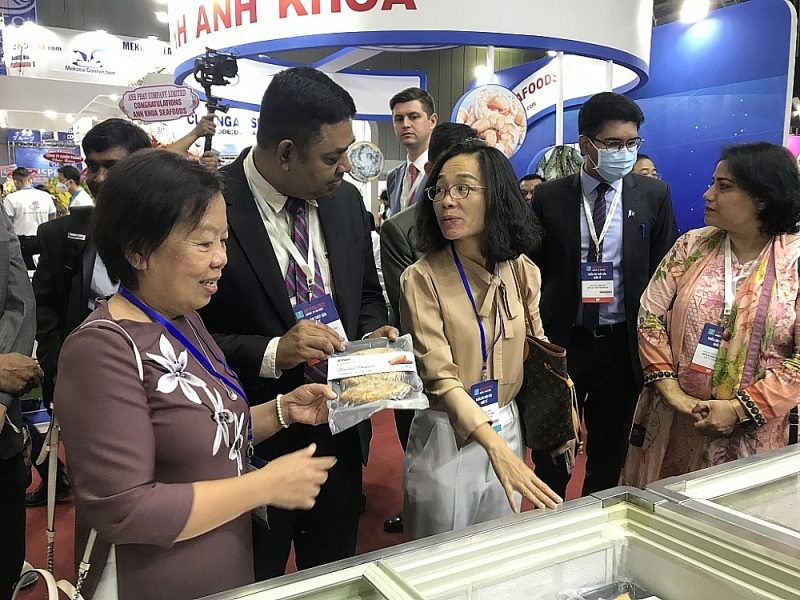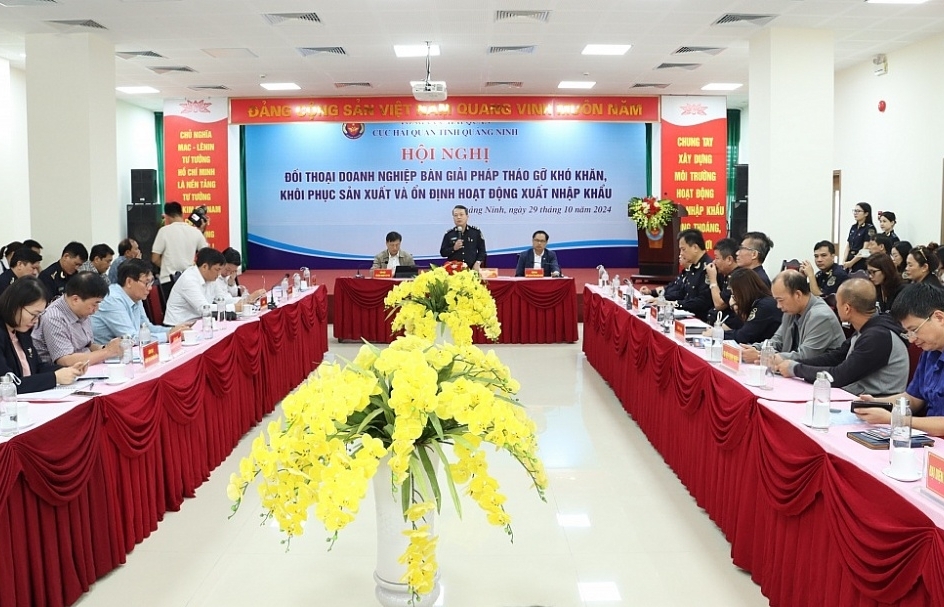Businesses find solutions to adapt to the post-Covid-19 market
 |
| Seafood businesses are looking for solutions to adapt to the post-Covid-19 market. Photo: T.H |
Increase deep processing
Assessing the market share of seafood products in terms of shrimp, experts said that Vietnamese shrimp accounts for the highest market share in the markets of Japan, Korea, the UK, and Australia. Ranked second in the EU market and fourth in the US market. The trend of consumers, especially after Covid-19, wants products with more integrated utilities, which means increased deep processing.
Assessing the trend of Vietnam's shrimp industry, Ho Quoc Luc, Chairman of the Board of Directors of Sao Ta Food Joint Stock Company, said that Vietnamese shrimp ranks in the top three in the world and the trend is to continue to conquer higher peaks.
With the advantage of being a country with the world's leading shrimp processing level with deep-processed products with high added value, suitable for the needs and tastes of major markets when the world economy recovers. After the pandemic, businesses are dominating the market, creating many large markets.
However, businesses also face significant challenges. Currently, due to the prolonged effects of the Covid-19 pandemic, the demand for high-priced products has decreased. Meanwhile, transportation and logistics costs are still high, which is a big disadvantage for Vietnam when the transportation distance to destination markets is very long.
For example, the cost of transporting one container of shrimp (about 15 tons) from Vietnam to the US is currently about US$20,000, while the cost of transporting a container from Ecuador to the US is only about US$5,000. Thus, only in terms of freight, one container of Vietnamese shrimp is US$15,000 higher, equivalent to 1kg of shrimp costing US$1 more than Ecuadorian shrimp.
The forecast that seafood demand will continue to increase in the long term also prompts other countries to have policies to promote the shrimp industry, including increasing farming, increasing production, improving processing levels, and market strategy increase international competitive pressure.
The government has a policy of accumulating land to establish more large-scale farms according to ASC and BAP standards to raise the level of Vietnamese shrimp. The processing industry expands in the direction of applying technology to reduce labor usage and increase labor productivity. Shrimp processing level is continuously improved, with eye-catching packaging, and is convenient to use. Logistics is increasingly perfecting and improving service capacity. In general, the shrimp value chain develops with synchronous and flexible participation links, more or less sharing benefits for each other.
The Vietnamese shrimp industry is trying to reach the milestone of one million tons of shrimp in 2022, and with the advantages that will gradually rise, maintain the leading position in the processing level, keep the highest proportion in the high-end market segment and maintain the highest proportion in the high-end market segment to achieve a high growth rate to rise to the top of the world in the coming years.
Adapt to the market
Commenting on the seafood export market trend, Ms. Le Hang, Deputy Director of VASEP.PRO said that the global demand for seafood has peaked and will decrease in the second half of 2022. A stronger USD will reduce demand in many markets including the EU and Japan.
Along with that, the increase in inventories makes importers limit their purchases and find ways to lower the prices of imported goods. That is also the reason why seafood export prices cannot maintain the high level as in the first half of the year. In particular, inflation reduces spending on seafood, consumers will give preference to species with moderate prices in line with declining incomes. Small shrimp, pangasius, fish cakes, surimi, and small sea fish are still in high demand but prices will decrease compared to the first half of the year.
The world seafood market in the past 5 years has grown by 16% with an annual import turnover of about US$148.5 billion; in which, shrimp accounted for the highest proportion and increased the most (29%), salmon increased 16%, and demand for tuna was less volatile. Import demand of the Chinese market has the most breakthrough with an increase of 71% after 5 years; followed by the US with an increase of 32%. Most markets increased demand, except for Japan, which decreased by 6%, and Germany, which decreased slightly by 0.6%.
Since the outbreak of the Covid-19 pandemic, in the first half of 2022, world seafood demand has recovered, Chinese consumers increasingly prefer high-quality, value-added seafood products. Vietnam accounts for 7-10% of China's imported seafood market share.
The US market has strong recovery demand for all products. However, with rising seafood prices and inflation, demand is expected to slow down in the second half of this year. Vietnam is currently the 5th largest supplier, accounting for 9% of the US seafood market share.
From the above fact, experts recommend seafood enterprises increase two-way trade between member markets of bilateral and multilateral FTAs, taking advantage of preferential tariffs, including Canada, Chile, Australia, and Mexico, EU.
Top seafood species consumed the most are shrimp, salmon, tuna, cod, pollock, pangasius, tilapia, and crab. In which, demand for shrimp will remain stable. because it is the preferred choice of consumers in major markets such as the US, EU, Japan, and Australia. Demand for white fish species continues to increase.
Related News

Quang Ninh Customs seeks solutions to promote import and export
10:34 | 02/11/2024 Customs

Quang Ninh Customs: Innovation in developing Customs-Business partnership
09:27 | 29/10/2024 Customs

Digital transformation in Customs sector is a revolution
10:45 | 28/10/2024 Customs

An Giang Customs announces businesses with tax arrears
14:51 | 24/10/2024 Anti-Smuggling
Latest News

Many factors affecting tuna exports in the last months of the year
19:38 | 02/11/2024 Import-Export

Vietnam still dominates Philippine rice import
19:36 | 02/11/2024 Import-Export
Vietnam cements ties with partners to engage in global semiconductor, AI industries
19:35 | 02/11/2024 Import-Export

Aquatic exports expected to rise in year-end despite challenges
19:33 | 02/11/2024 Import-Export
More News

Trade Defense: The Key to Success for Vietnamese Businesses
10:39 | 02/11/2024 Import-Export

Lao Cai Customs sees a triple-digit surge in export-import turnover
10:37 | 02/11/2024 Import-Export

Coconut is expected to become a billion-dollar export item
16:40 | 01/11/2024 Import-Export

Plastic exporters interested in converting to recycling technology
16:36 | 01/11/2024 Import-Export

Logistics sector must embrace innovative trends to stay competitive
16:34 | 01/11/2024 Import-Export

Vietnam’s agro-forestry-aquatic product exports likely to set new record
16:32 | 01/11/2024 Import-Export

UKVFTA greatly benefits Vietnam-UK trade: Experts
14:19 | 31/10/2024 Import-Export

Agricultural exports likely to exceed 60 billion USD amid challenges
14:18 | 31/10/2024 Import-Export

Vietnam-Philippines trade likely to exceed 8 billion USD for first time
14:17 | 31/10/2024 Import-Export
Your care

Many factors affecting tuna exports in the last months of the year
19:38 | 02/11/2024 Import-Export

Vietnam still dominates Philippine rice import
19:36 | 02/11/2024 Import-Export
Vietnam cements ties with partners to engage in global semiconductor, AI industries
19:35 | 02/11/2024 Import-Export

Aquatic exports expected to rise in year-end despite challenges
19:33 | 02/11/2024 Import-Export

Trade Defense: The Key to Success for Vietnamese Businesses
10:39 | 02/11/2024 Import-Export





